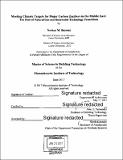| dc.contributor.advisor | John. E. Fernandez. | en_US |
| dc.contributor.author | Bayomi, Norhan M. (Norhan Magdy Mohamed) | en_US |
| dc.contributor.other | Massachusetts Institute of Technology. Department of Architecture. | en_US |
| dc.coverage.spatial | aw----- | en_US |
| dc.date.accessioned | 2017-09-15T15:38:55Z | |
| dc.date.available | 2017-09-15T15:38:55Z | |
| dc.date.copyright | 2017 | en_US |
| dc.date.issued | 2017 | en_US |
| dc.identifier.uri | http://hdl.handle.net/1721.1/111545 | |
| dc.description | Thesis: S.M. in Building Technology, Massachusetts Institute of Technology, Department of Architecture, 2017. | en_US |
| dc.description | Cataloged from PDF version of thesis. | en_US |
| dc.description | Includes bibliographical references. | en_US |
| dc.description.abstract | Energy is a key ingredient to facilitate economic development in the Middle East. Expectations for a rapidly growing economy in the next decade will likely cause an increase in the fraction of energy consumed domestically tumbling what is available for export. Rising living standards, energy-intensive urban expansion and mounting power demands compound the energy challenge in the Middle East. After Paris Climate Agreement in 2015, countries in the Middle East have committed to curb their GHG emissions and increase the deployment of renewable technologies. As a result, energy systems have been under significant transitions driven by environmental policies and economic development. The thesis explores the role of energy supply and power generation sector in the Middle East to meet climate goals. Emissions are examined under the 450- pathway for the Middle East, developed by the International Energy Agency (IEA) to contribute to the global goal of staying below 2°C. The focus is given to four countries, namely Iran, Saudi Arabia, Kuwait and the UAE, which account for around 76% of the region's CO₂ emissions. Accordingly, the main objective is to first, examine possibilities from transitioning to natural gas usage in the total primary energy supply mix. Second, examine current power generation strategies to assess their contribution under 450-emission scenario. Finally, develop an optimal electricity generation mix that satisfies emission targets in 2020 and 2030 using Mean Variance Portfolio Theory (MVP). Data collected throughout the thesis and results of the analysis are compiled and presented in an interactive web tool (MENA-CC.com) that allows users to have open access to energy data sets, graphically conduct country-to-country comparison, examine different power scenarios and assess emissions trajectories relative to the 450-emission target. | en_US |
| dc.description.statementofresponsibility | by Norhan M. Bayomi. | en_US |
| dc.format.extent | 149 pages | en_US |
| dc.language.iso | eng | en_US |
| dc.publisher | Massachusetts Institute of Technology | en_US |
| dc.rights | MIT theses are protected by copyright. They may be viewed, downloaded, or printed from this source but further reproduction or distribution in any format is prohibited without written permission. | en_US |
| dc.rights.uri | http://dspace.mit.edu/handle/1721.1/7582 | en_US |
| dc.subject | Architecture. | en_US |
| dc.title | Meeting climate targets for the role of natural for major carbon emitters in the Middle East : gas and renewable technology transitions | en_US |
| dc.type | Thesis | en_US |
| dc.description.degree | S.M. in Building Technology | en_US |
| dc.contributor.department | Massachusetts Institute of Technology. Department of Architecture | |
| dc.identifier.oclc | 1003490203 | en_US |
